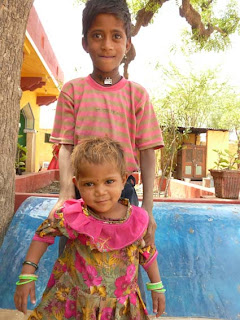There were a few things that made me smile today though. One of my coping strategies is to think of a day as a success if I achieve one thing, have one good conversation or experience one interesting/enlightening/amusing situation. The great thing is that days are often filled with many of these moments.
So here's what happened today:
1) This morning one of our buffalos gave birth. I saw the baby when it was a couple of hours old, exhausted, curled up and being licked by its mother who still had the water bag hanging out of her. Raju, who looks after the animals, and his co-workers were worried. It was a hot day and they needed to keep the calf cool, as well as show it how to take milk. They even gave it a hemp grain bag to lie on in the shade. They also milked the mother, apparently the first milking after giving birth is very strong milk, presumably full of goodness for the baby. No one drinks it straight but instead make nourishing lassis from it (making curd from the milk, then mixing with cool water and sugar for a refreshing drink). I'm told buffalo milk is strong anyway, and I look forward to trying it. Mama said she will teach her daughter Ganoo and I how to milk the buffalo, something I'm keen on doing as I can't do it regulary in England!
 2) We were running dangerously low on water because of the pump situation, even the two huge water storage tanks we kept for emergencies were almost empty and we weren't sure when the power would come back on. All us children took every bucket, mudkey (clay water pot) and bottle we could find down to the village hand pump just outside the boundary of our house, much to the amusement of the villagers. You see, we have an electric pump, but in times like this they were the winners and could still draw water without the need for electricity. After waiting our turn, I filled my mudkey, working my biceps and attempted to carry it home resting on my shoulder. Unfortunatley I haven't quite mastered the art of carrying it and at this comparitively long distance lost about a litre down my kurta, causing much giggling from the village women who were encouraging me to put it on my head like they did. Well I made it home carrying the pot in my arms and feeling like I'd had my hand pump initiation.
2) We were running dangerously low on water because of the pump situation, even the two huge water storage tanks we kept for emergencies were almost empty and we weren't sure when the power would come back on. All us children took every bucket, mudkey (clay water pot) and bottle we could find down to the village hand pump just outside the boundary of our house, much to the amusement of the villagers. You see, we have an electric pump, but in times like this they were the winners and could still draw water without the need for electricity. After waiting our turn, I filled my mudkey, working my biceps and attempted to carry it home resting on my shoulder. Unfortunatley I haven't quite mastered the art of carrying it and at this comparitively long distance lost about a litre down my kurta, causing much giggling from the village women who were encouraging me to put it on my head like they did. Well I made it home carrying the pot in my arms and feeling like I'd had my hand pump initiation. 3) I would have to rate Battleships as one of my top 5 games and coincidentally have it with me in India, although being the only foreigner in a family who can't speak much english I haven't had a chance to play many of the games I brought with me. With no power we were all sat in Grandma's cool bedroom with its two foot thick walls, and I thought I'd teach my cousin and brother how to play. After much explanation we were almost playing to the actual rules although i suspected some peeking over or some very lucky guesses! Then the power came on and they rushed to the TV.
3) I would have to rate Battleships as one of my top 5 games and coincidentally have it with me in India, although being the only foreigner in a family who can't speak much english I haven't had a chance to play many of the games I brought with me. With no power we were all sat in Grandma's cool bedroom with its two foot thick walls, and I thought I'd teach my cousin and brother how to play. After much explanation we were almost playing to the actual rules although i suspected some peeking over or some very lucky guesses! Then the power came on and they rushed to the TV. Photos: Raju pushing his daughter Sumi next to the calf for our photo shoot; Practising how to carry the mudkey on my head later on in the evening; Pratap and Kanoo concentrating on their next battleship moves.
Photos: Raju pushing his daughter Sumi next to the calf for our photo shoot; Practising how to carry the mudkey on my head later on in the evening; Pratap and Kanoo concentrating on their next battleship moves.





















